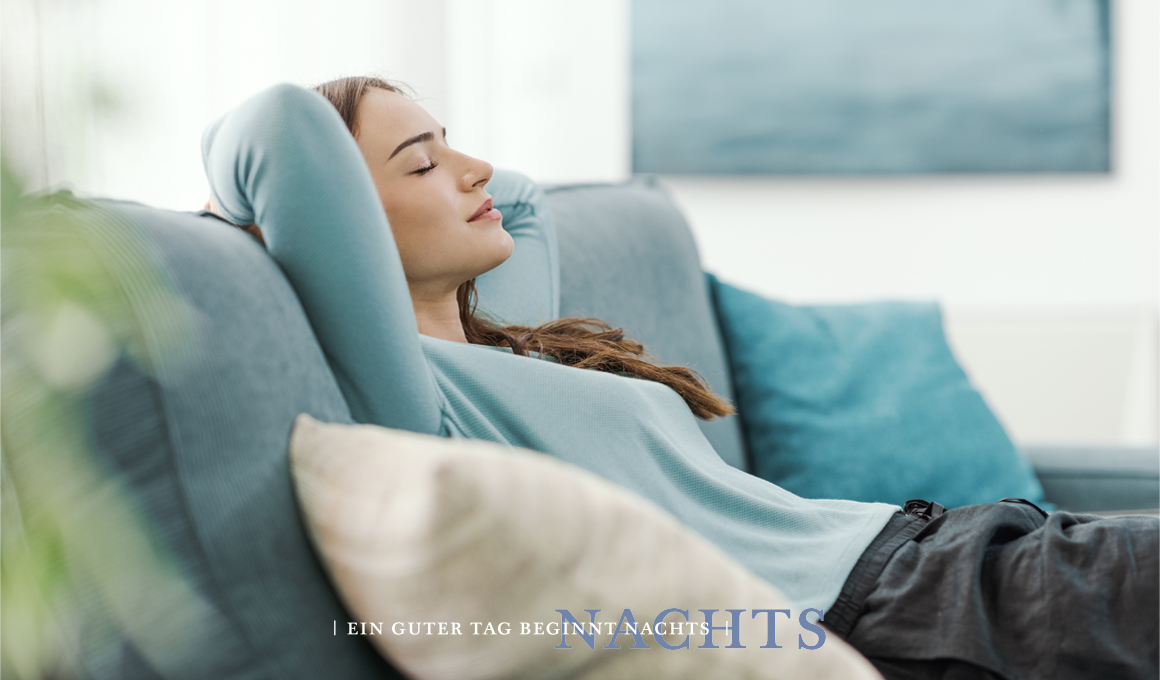When you hear the word “slumber”, you immediately think of security, warmth and a retreat from the hustle and bustle of everyday life. Many of us associate it with that brief moment when our eyes become heavy, our thoughts become quieter and our body noticeably lets go. But what exactly is slumbering? Is it healthy to slumber during the day or is it more harmful? And how does it differ from a power nap or the classic afternoon nap?
What is meant by slumbering?
Slumbering describes the transition between wakefulness and sleep. It is a light, superficial sleep in which we do not enter the deep sleep phase. It is therefore more like dozing or briefly nodding off. Unlike night-time sleep, slumbering is not about going through all the sleep cycles, but about getting away from everyday life for a few minutes. It is precisely this brevity that makes slumbering so pleasant: we feel refreshed without slipping into a deep sleep. Slumbering gives the body the opportunity to gather new strength for a moment.
Slumber in everyday life
Slumbering can look very different. Some people sink back into their pillows in bed at the weekend, while others take the opportunity to do so on the sofa in the afternoon. Many people also close their eyes for a few minutes when traveling, on the train or plane. Even in the office during the lunch break or in the morning after the alarm clock rings, when we roll over again, we encounter slumbering.
Slumbering in the morning – pressing the snooze button on the alarm clock – is a widespread phenomenon. Many people use these minutes to start the day gently. Whether this is restful or counterproductive depends, among other things, on how long it takes: Those who only fall asleep for a short time can feel a positive effect. However, those who press the snooze button several times are more likely to upset their circulation and end up feeling more tired than before.
You can find out more interesting information on this topic in our article Snooze – would you rather not have a snooze button?
Is slumbering healthy?
Sleep research shows that even short sleep episodes have a whole range of positive effects. Just a few minutes with your eyes closed can reduce stress, lower blood pressure and increase concentration. The brain uses the short break to sort information and consolidate memories. The immune system also benefits, as those who regularly take short slumbers are less susceptible to infections.
Slumbering also contributes to inner peace and balance. If you allow yourself to close your eyes briefly during the day, you will feel the tension ease and your mood lift. It is a conscious shutdown, a short, refreshing restart for body and mind.
Snooze, slumber and power nap – what’s the difference?
The terms snooze, slumber and power nap are often confused or used interchangeably. However, these are very different types of short sleep. Slumbering is the most natural form – unplanned, short and superficial. A nap generally lasts longer, usually around half an hour or even up to an hour, while a power nap is more clearly defined: ten to twenty minutes of light sleep that provides energy without sinking into the deep sleep phases. Slumbering is therefore the gentle, spontaneous version of a power nap – not planned, but a brief moment of rest.
If you would like to find out more about the different forms of short naps, you can find lots more information in our articles Powernap: 20 minutes of relaxation in between! and Naps – short break, big effect.
When is the best time to slumber?
From a biological point of view, our body has two natural rest phases: at night and at midday. The noticeable dip in performance after lunch is no coincidence, but part of our biorhythm. If you snooze for a few minutes between 1 and 3 p.m., you make the most of this internal rhythm and feel refreshed and more productive afterwards. Snoozing too late – in the late afternoon or evening, for example – can disrupt night-time sleep.
Slumbering is closely linked to our circadian rhythm, which is controlled by light, hormones and habits. It is easier to drift off to sleep in dark surroundings because the body produces more melatonin. This also explains why slumbering is sometimes more difficult in summer than in the darker months, as light has a direct effect on our internal clock.
Can slumbering be harmful?
In our performance-oriented society, slumbering is sometimes seen as a sign of laziness. However, it is actually more of an act of self-care: allowing yourself to rest for a short time gives you the gift of mindfulness and promotes your well-being. This brief pause reduces stress and acts as a moment of deceleration.
However, it becomes problematic if you slumber too often or for too long. This can be an indication that your night’s sleep is not restful enough – due to sleep disorders, insomnia or physical factors such as the need to urinate at night. Anyone who regularly sleeps very late during the day also risks throwing their internal clock out of balance. As in many other cases, the dose makes the poison: short, targeted periods of rest are beneficial, while long periods of slumber can disrupt a restful night’s sleep.
How do you sleep in other cultures?
In many cultures, slumbering is a natural part of everyday life. In southern Europe, the siesta is traditionally an integral part of the daily rhythm. It was originally introduced to bridge the hot midday hours and give the body a rest. In Japan, on the other hand, there is the “inemuri”, the short snooze in public. Whether on the train or even in the office – here, napping is not seen as a sign of laziness, but is often seen as an expression of diligence and commitment. If you close your eyes on the train in Japan, you are signaling that you have worked hard and now deserve a little break.
Short lunch breaks are also widespread in China and Latin America. In Latin America, it often takes the form of a short siesta with the family, while in China schoolchildren and employees take a break in many places. The lights are dimmed in schools and employees in offices put their heads down on their desks for half an hour. Here, too, slumbering is not seen as a weakness, but as a necessary form of regeneration. While we in this country often see napping as a luxury or an exception, in other parts of the world it is taken for granted and culturally valued.
5 tips for restful slumber
To ensure that slumbering is not just a short break but a real rest, it is worth following a few simple rules.
- Pay attention to the right duration: Those who doze for no longer than twenty minutes feel refreshed afterwards. That way, you won’t slip into a deep sleep and will feel refreshed afterwards.
- Choose the right time: The early afternoon is perfect to compensate for the natural low in performance.
- Ensure peace and quiet and darkness: A relaxed environment makes it easier to fall asleep and prevents disturbances.
- Lying comfortably: A comfortable position helps the body to rest briefly and relaxed.
- Use small aids: A sleep mask, a light blanket or a neck pillow can significantly increase your sleeping comfort.
Relaxed slumber with billerbeck
Whether for a short break in between or for a restful night’s sleep – slumbering is particularly relaxing with the right bedding from billerbeck.
The NOVOFLEX neck support pillow offers a high level of support for back and side sleepers. The cold foam core with innovative wave-cut technology relieves pressure on the neck and shoulders, while the removable insert plate allows four individual heights. The cotton satin cover is breathable, removable and washable up to 60 °C, which is ideal for allergy sufferers.
With its ergonomic butterfly shape, the HEINZI – Fiber pillow for stomach sleepers offers special comfort for stomach sleepers, as the arms can comfortably surround the pillow and the head lies relaxed. The filling of moldable fiber balls adapts individually and is ideal for house dust allergy sufferers. Thanks to the removable inner cushion, HEINZI is easy to clean and can be washed at 60 °C. Incidentally, its compact shape also makes it ideal for a quick snooze at your desk. In addition to the fiber filling, HEINZI is also available in a version with down.
The COSICOTTON cotton comforter is vegan, GOTS-certified and impresses with its sustainable quality. The fine soft-batiste cover and organic cotton filling make it particularly skin-friendly and breathable. Easy-care and washable up to 40 °C, it is available in various sizes and warmth levels – ideal for anyone who wants to use natural materials for their comforter and consciously avoid animal products.














